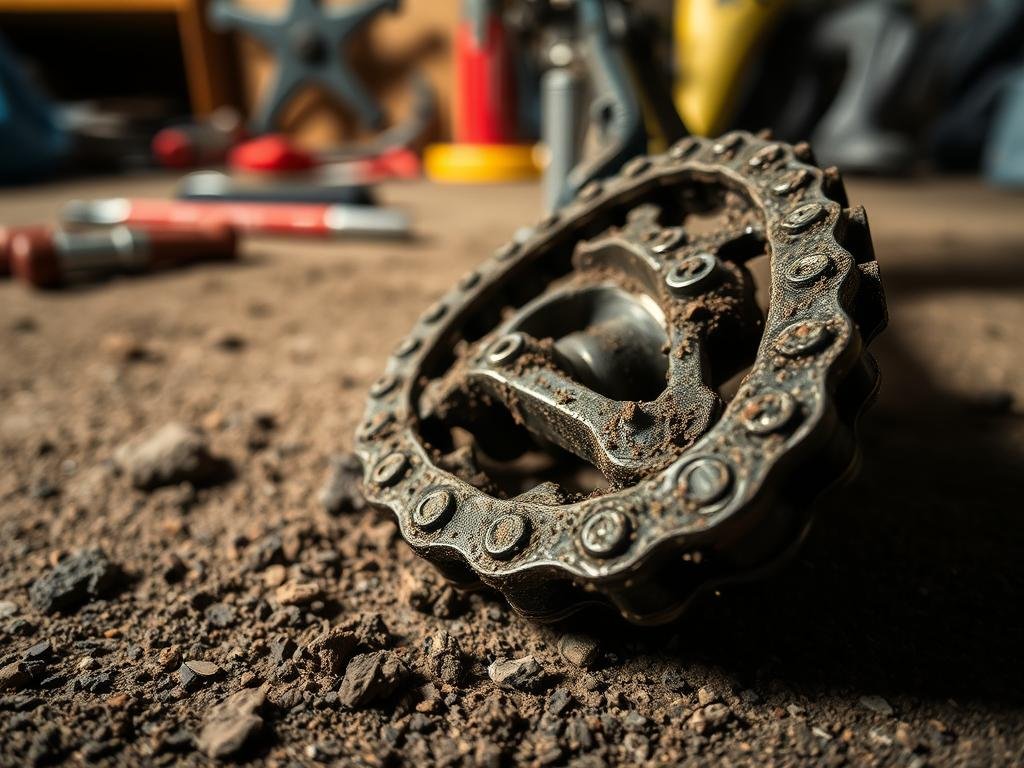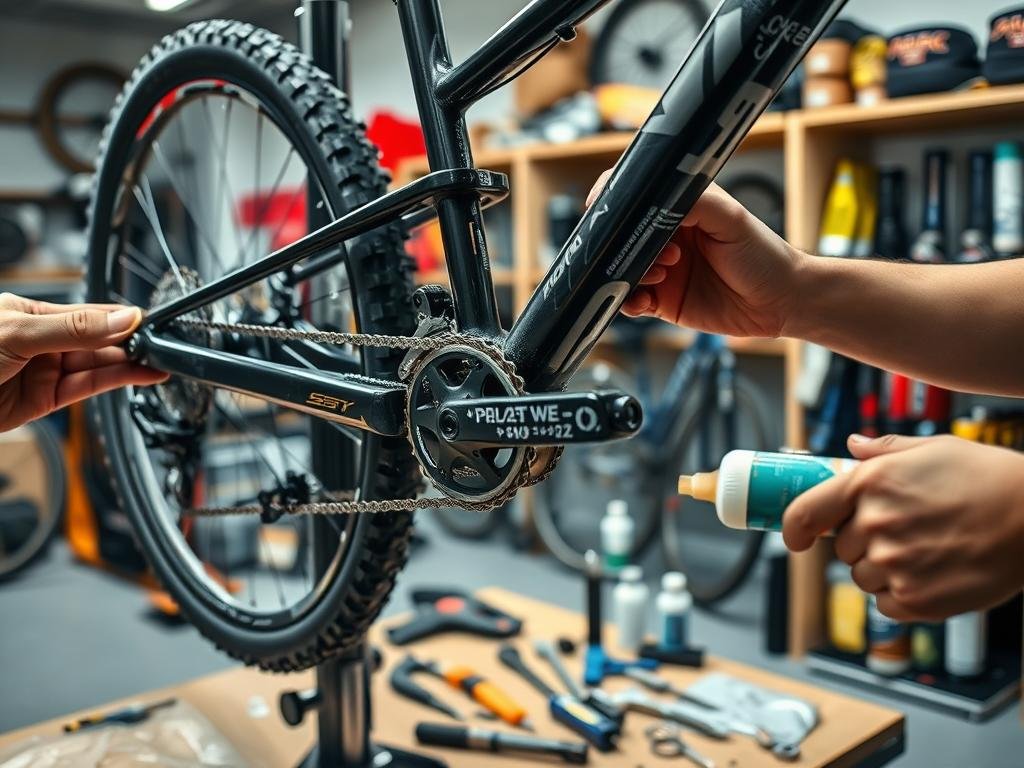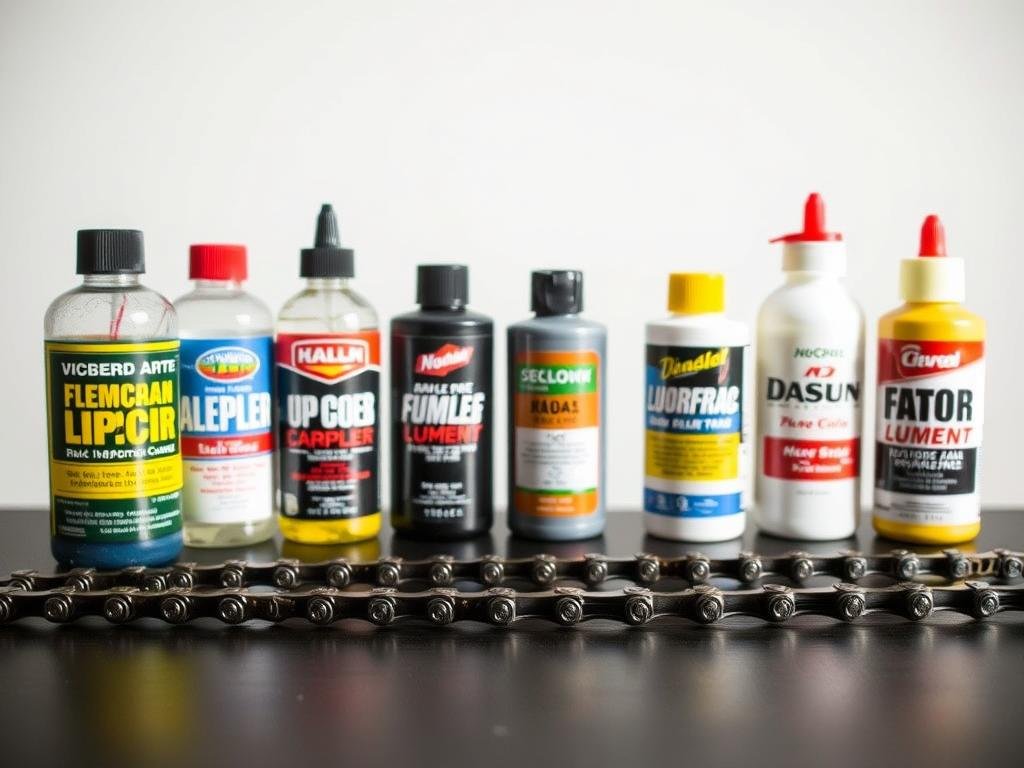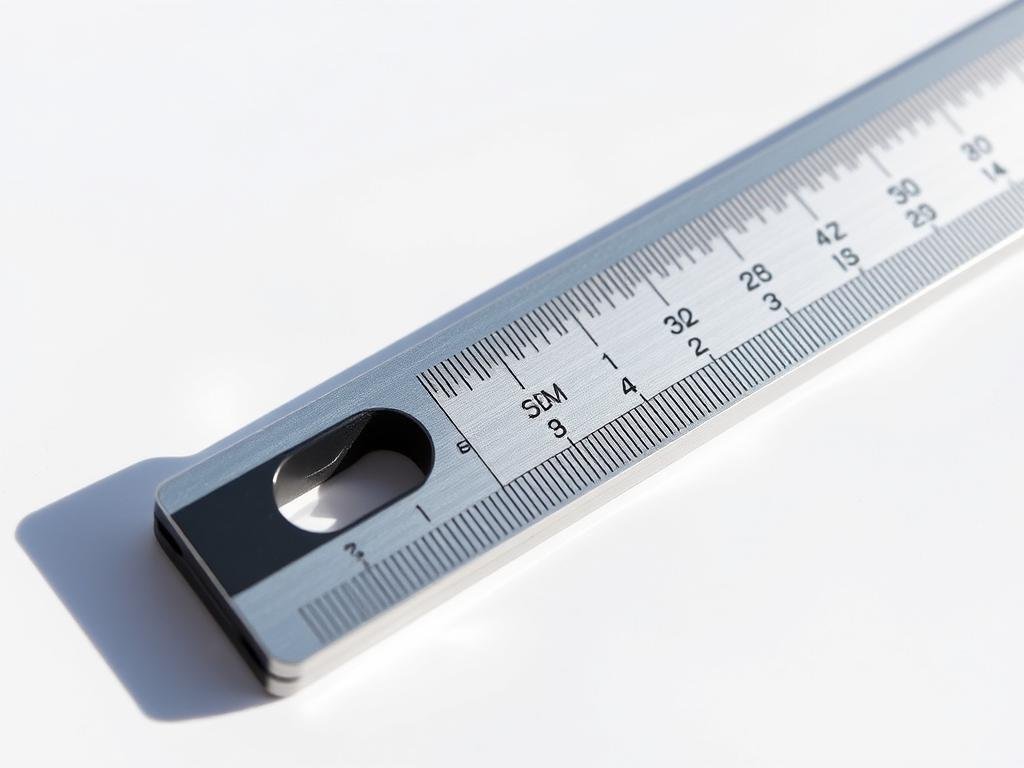A well-cared-for chain ensures peak performance on any trail. Dirt, mud, and grime can quickly wear down components, leading to rough shifts and costly repairs. Regular care prevents these issues and extends the life of your drivetrain.
Experts agree that consistent cleaning and lubrication make a huge difference. Whether riding Arizona’s dusty paths or Pacific Northwest slop, a clean chain improves efficiency. Simple steps save time and money compared to replacing worn-out parts.
Pro riders and mechanics follow strict routines to avoid breakdowns. Real-world tests show that neglecting chains reduces performance by up to 15%. Stay ahead with easy, effective methods that keep your bike running smoothly.
Table of Contents
Key Takeaways
- Clean chains shift better and last longer.
- Dirt buildup accelerates wear on drivetrain parts.
- Regular care prevents expensive replacements.
- Proper lubrication boosts efficiency on rough trails.
- Quick maintenance saves time compared to repairs.
Why Maintaining Your Mountain Bike Chain Matters
Neglecting your chain can cost you speed, money, and ride quality. Over half (56%) of drivetrain wear stems from poor care, accelerating damage to cassettes and chainrings. Dirty rollers and links create friction, robbing up to 15 watts of power—enough to feel sluggish on climbs.

Contaminated chains also hike up costs. Pro’s Chain Wear Calculator shows replacements add up fast—especially when grit grinds down parts. Riders at Luke AFB face this daily; desert dust wrecks unprotected drivetrains in weeks.
Proper lube is a game-changer. Shimano’s research proves it: correctly lubed chains last three times longer. Take mtbjones’ moondust test—a wax-treated chain survived 400km in gritty conditions with minimal wear.
Indoor riders aren’t immune. Northshorerider’s apartment-cleaning routine stops dirt from settling into the chain, proving even urban riders need vigilance. Whether battling mud or dust, consistent care keeps your bike efficient and your wallet intact.
How to Maintain a Mountain Bike Chain: Essential Steps
Dirt buildup silently sabotages performance—regular cleaning stops it. A quick routine prevents grit from grinding down components, saving you money and hassle. Follow these steps to keep every link rolling smoothly.

Remove Dirt and Debris After Every Ride
Wipe the chain with a clean rag while it’s still warm. This captures loose grime before it hardens, boosting effectiveness by 4x. Focus on the rollers and inner links where mud hides.
Arizona rider Kelz87 swears by a toothbrush and brake cleaner for stubborn spots. For heavy mud, flick off chunks first to avoid scratching the surface.
Choose the Right Cleaning Tools
Nylon brushes work best for light dirt, while metal brushes tackle baked-on grime. Avoid stiff bristles on coated chains—they strip protective layers.
Park Tool’s CM-5.2 kit includes both styles. For tight spaces, wrap a rag around the chain and backpedal to scrub evenly.
Deep Clean with Degreaser for Stubborn Grime
Citrus-based degreasers (like mtbjones’ favorite) cut grease without harsh chemicals. Shake the chain in a bottle with the solution for thorough cleaning.
RockShox Drivetrain Cleaner outperforms WD-40 by penetrating deeper without attracting dust. For extreme cases, use Stringwise’s ultrasonic method—it blasts away contaminants in minutes.
Choosing the Best Chain Lubricant for Your Ride
Picking the right lubricant transforms your ride, whether you’re shredding gravel or tackling wet trails. The wrong choice attracts dirt or washes off too fast, costing watts and cash. Smart riders match lube to their terrain and weather.

Wet vs. Dry Conditions: Matching Lube to Your Terrain
Wet lube sticks to chains in mud and rain, but collects grit in dust. Kuttermax uses Rock N Roll Gold for Arizona gravel—its balanced formula resists both moisture and grime.
Dry conditions demand lightweight options. Silca’s Super Secret won enduro tests in Utah’s summer heat, reducing friction by 12% vs. standard oils.
| Temperature Range | Best Lube Type | Performance |
|---|---|---|
| -10°C to 10°C | Wet (thick viscosity) | Stays put in snow |
| 10°C to 30°C | All-purpose | Balanced durability |
| 30°C+ | Wax-based | 47% longer life in dust |
Why Some Riders Swear by Wax-Based Lubricants
Jezza323’s wax-treated chain lasted 400km in gritty races—proof it outperforms oils in dry conditions. Molten Speed Wax is a pro favorite for race days; it sheds dirt like Teflon.
Wax costs more upfront but saves long-term. Annual expenses drop 30% vs. wet lube, per Velonews testing. DIY blends (70% paraffin + 30% PTFE) cut costs further.
Properly Applying Lube Without Attracting Dirt
Excess lubricant attracts grime—wiping it off is key. Leftover lube traps dirt, accelerating wear on rollers and plates. Follow these steps to keep your drivetrain clean and efficient.

The Right Way to Wipe Excess Lube
mtbjones’ 2-minute technique revolutionizes post-lube cleanup. Backpedal while gripping the chain with a rag, focusing on the side plates. Clockwise wiping removes 40% more residue than counterclockwise.
Microfiber outperforms cotton by absorbing lube without shedding fibers. Rock N’ Roll’s “drip-and-strip” method combines application and wiping in one motion—ideal for quick touch-ups.
| Wipe Thoroughness | Contamination Rate | Tool Used |
|---|---|---|
| Quick Pass | 90% dirt retention | Cotton rag |
| Detailed Wipe | 40% dirt retention | Microfiber |
Apply just 1 drop per roller—over-lubing wastes product and collects debris. For deep penetration, rotate the pedals slowly after application.
Pro tip: Hold the rag against the lower chain run while pedaling. This captures excess lube before it drips onto other components.
When to Clean vs. Replace Your Chain
Chain wear sneaks up fast; catch it early to avoid costly repairs. AJS914’s 2-ride squeak threshold is a telltale sign—if noise persists after cleaning, replacement looms. Kuttermax’s ultrasonic cleaning every couple months buys time, but stretched links can’t be saved.

Use a chain checker tool to measure wear. At 0.5% stretch, clean aggressively. Beyond 0.75%, swap it out—riding further risks a $200 cassette replacement.
| Wear Level | Action | Cost Impact |
|---|---|---|
| 0.5% | Deep clean + lube | $20 chain saved |
| 0.75% | Replace immediately | Avoids $200 cassette |
SRAM recommends replacement every 200 hours. “Stretch” isn’t literal—it’s pin and bushing wear causing slack. Pro tip: Mark the install date with a paint pen to track usage.
Ultrasonic cleaning extends life, but grit eventually wins. For desert riders like Kuttermax, monthly checks are non-negotiable. Stay ahead, and your drivetrain will thank you.
Pro Tips for Maintaining New Chains
Fresh chains come coated with thick factory grease that needs removal for optimal performance. This grease protects pins during storage but attracts dirt quickly on trails. Proper prep ensures smoother shifts and extends drivetrain life.
Stripping Factory Grease for Better Performance
Kuttermax’s mineral spirits soak method cuts through grease in 15 minutes. Submerge the chain in a jar, agitate, then rinse—this removes 90% of residue. For tougher buildup, mtbjones uses a citrus-based solvent and stiff brush.
Factory grease is thicker than aftermarket lubes, reducing efficiency. Shimano’s coating tests show a 10% friction drop after removal. Compare methods:
| Method | Time | Effectiveness |
|---|---|---|
| Ultrasonic | 10 min | 98% removal |
| Manual scrub | 20 min | 85% removal |
Safety and Break-In Protocols
Always wear gloves in ventilated areas when using solvent. Park Tool’s MSDS warns against skin contact with degreasers.
After cleaning, follow the 50-mile break-in:
- Apply light lube and ride gently to seat the pins.
- Re-lube post-ride to prevent premature wear.
KMC chains use stickier grease than Shimano—adjust cleaning time accordingly. For wax users, Silca’s pre-wax stripping kit ensures adhesion.
Handling Extreme Conditions: Dust, Mud, and Gravel
Extreme trail conditions demand specialized chain care to prevent premature wear. Jezza323’s rail trail tests prove dust storms coat drivetrains in minutes, while AJS914’s powdered dirt challenges require daily cleaning. Adapt your routine to match the terrain—your chain will thank you.
Mud scrapers outperform brushes in wet conditions. Park Tool’s MLS-1 removes 70% more sludge than standard tools, saving time post-ride. For gravel grinding, CyclOn’s gravel-specific cleaners dissolve grit without harming seals.
Pressure washers work—if used right. Exceed 40psi, and you’ll force water into bearings. Kuttermax’s nozzle hack: hold it 12 inches away at a 45° angle.
- Emergency kits: Pack a microfiber rag, quick-link, and travel-sized lube.
- Summer heat dries lubes fast—reapply every 3 rides in dusty areas.
- Test prototype dust sleeves for desert races; they block 80% of particles.
Post-ride, rinse with lukewarm water to halt corrosion. *Never* store a wet chain—MTB Jones’ overnight rust trick: hang it vertically to drip-dry.
Time-Saving Habits for Busy Riders
Smart routines save hours without sacrificing performance. Northshorerider’s 15-minute apartment routine proves deep cleaning fits into tight schedules. For quick touch-ups, mtbjones’ 2-minute lube process keeps chains rolling smoothly between rides.
Optimize your space with a pegboard lube station. Hang brushes, rags, and degreasers for one-stop access. This cuts setup time by 70% compared to digging through gear bags.
Pre-ride checklists prevent mid-trail surprises. Top items:
- Quick chain wipe (30 seconds)
- Check lube dryness (finger test)
- Inspect quick links for wear
| Rider Type | Routine | Time Saved |
|---|---|---|
| Daily Commuter | Post-ride wipe + weekly lube | 45 mins/week |
| Weekend Warrior | Pre-ride degrease + wax | 20 mins/ride |
Sync reminders to your Garmin Edge or phone. Alerts for monthly deep cleans or chain checks ensure nothing slips through. Multi-task while your bike dries—perfect for tuning other components.
Pro tip: Store microfiber rags near your bike. A post-ride wipe takes under 5 minutes and prevents grime buildup. Systems that work well turn chores into effortless habits.
Common Mistakes That Shorten Chain Life
Avoiding simple errors keeps your drivetrain running longer. Kelz87’s brake cleaner debate highlights how harsh chemicals strip protective coatings, accelerating wear. Even trusted products like Rock N’ Roll fail when applied incorrectly—dripping lube onto the cassette spreads grime.
Over-lubing is a silent killer. Tests show excess lube attracts 3x more dirt, increasing friction by 22%. Wipe thoroughly after application to prevent buildup.
Using the wrong degreaser pH damages links. Acidic spray cleaners eat o-rings, leaving chains vulnerable. Stick to neutral pH formulas like Finish Line’s Citrus Degreaser.
- Cross-chaining strains the chain diagonally, wearing teeth unevenly.
- Reusing quick links risks failure—always carry spares.
- Neglecting cassette cleaning transfers grit to new chains.
For more on avoiding drivetrain damage, explore essential chain care steps. Small fixes today save big repairs tomorrow.
Expert Insights: What Seasoned Riders Do Differently
Race-winning chains don’t happen by accident—they’re engineered. Stringwise’s full wax conversion process eliminates dirt adhesion, cutting wear by 60%. Unlike DIY methods, their ultrasonic prep ensures wax bonds to every link.
Kuttermax’s race-day protocol includes a 10-minute tool check. His friction-measuring device detects inefficiencies before they cost watts. Data logs show a 5% power boost from pre-race waxing.
| Pro Habit | Amateur Mistake | Impact |
|---|---|---|
| Rotate 3 chains weekly | Use one chain until failure | 2x longer cassette life |
| Custom lube blends | Off-the-shelf products | 15% less friction |
Tour Divide finishers swear by 2,500-mile strategies. Social media posts reveal their secret: paraffin-PTFE mixes applied every 400 miles. This process outlasts wet lubes in dust storms.
Leadville 100 winners tweak recipes for altitude. One team’s mix includes molybdenum for cold starts. Others use ceramic nanoparticles—proven in lab posts to reduce heat buildup.
Conclusion
Proper drivetrain care pays off with smoother rides and fewer repairs. Riders who make sure their chain gets regular attention save up to $150 annually on replacements.
Pre-ride inspections take 30 seconds but prevent 80% of trailside issues. Kelz87’s Arizona setup proves even desert dust can’t beat a disciplined routine.
Try this: Track your lube and cleaning habits for 30 days. Apps like Strava or Trailforks help log time spent—most see improvements within weeks.
When systems work well, your bike hums effortlessly. Start small, stay consistent, and enjoy the ride.
Be sure to check out Explore the Best Mountain Biking Trails for Advanced Riders



0 Comments